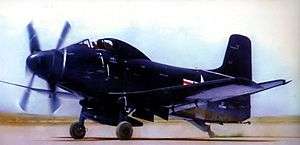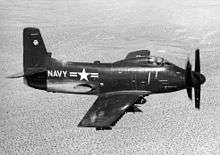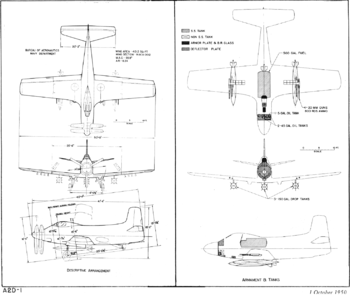Douglas A2D Skyshark
| A2D Skyshark | |
|---|---|
 | |
| Role | Attack aircraft |
| Manufacturer | Douglas Aircraft Company |
| First flight | March 26, 1950 |
| Status | Canceled |
| Primary user | United States Navy |
| Number built | 12 (4 never flew) |
| Developed from | A-1 Skyraider |
The Douglas A2D Skyshark was a turboprop-powered attack aircraft built by the Douglas Aircraft Company for the United States Navy.
Design and development

On 25 June 1945, the Bureau of Aeronautics (BuAer) asked Douglas Aircraft for a turbine-powered, propeller-driven aircraft.[1] Three proposals were put forth in the next year and a half: the D-557A, to use two General Electric TG-100s in wing nacelles; the D-557B, the same engine, with counter-rotating propellers; and the D-557C, to use the Westinghouse 25D.[1] These were canceled, due to engine development difficulties, but BuAer continued to seek an answer to thirsty jets.[1]
On 11 June 1947,[1] Douglas got the Navy's letter of intent for a carrier-based turboprop. The need to operate from Casablanca-class escort carriers dictated the use of a turboprop instead of jet power.[2] The advantages of turboprop engines over pistons was in power-to-weight ratio and the maximum power that could be generated practically. The advantage over jets was that a turboprop ran at near full RPM all the time, and thrust could be quickly generated by simply changing the propeller pitch.

While resembling the AD Skyraider, the A2D was an entirely different airplane, as it had to be, the Allison XT-40-A2 at 5,100 hp (3,800 kW)[3] having more than double the horsepower of the Skyraider's R3350,[3] with the XT40 installation on the Skyshark using contra-rotating propellers to harness all the available power. Wing root thickness decreased, from 17% to 12%, while both the height of the tail and its area grew.[3]
Engine development problems delayed the first flight until 26 May 1950, made at Edwards Air Force Base by George Jansen.[3]
Navy test pilot Cdr. Hugh Wood was killed attempting to land the first prototype XA2D-1, BuNo 122988, on 19 December 1950, on its 15th flight. He was unable to check the rate of descent, resulting in a high-impact crash on the runway.[4] Investigation found the starboard power section of the coupled Allison XT40A turboprop engine had failed and did not declutch, allowing the Skyshark to fly on the power of the opposite section, nor did the propellers feather. As the wings' lift disappeared, a fatal sink rate was induced. Additional instrumentation and an automatic decoupler was added to the second prototype, but by the time it was ready to fly on 3 April 1952, sixteen months had passed, and with all-jet designs being developed, the A2D program was essentially dead. Total flight time on the lost airframe was barely 20 hours.[5]
Allison failed to deliver a "production" engine until 1953, and while testing an XA2D with that engine, test pilot C. G. "Doc" Livingston pulled out of a dive and was surprised by a loud noise and pitch up. His windscreen was covered with oil and the chase pilot told Livingston that the propellers were gone. The gearbox had failed. Livingston successfully landed the airplane. By the summer of 1954, the A4D was ready to fly. The escort carriers were being mothballed, and time had run out for the troubled A2D program.[6]
Due largely to the failure of the T40 program to produce a reliable engine, the Skyshark never entered operational service.
Twelve Skysharks were built, two prototypes and ten preproduction aircraft. Most were scrapped or destroyed in accidents, and only one has survived.[7]
Aircraft on display
- A2D-1 Skyshark, BuNo. 125485, is at the airport in El Cajon, California as of 30 March 2016. It was restored for static display by Pacific Fighters ca. 1995.[8]
Specifications (XA2D-1)

Data from Encyclopedia of American Aircraft[9]
General characteristics
- Crew: 1
- Length: 41 ft 3 in (12.58 m)
- Wingspan: 50 ft 0 in (15.24 m)
- Height: 17 ft 1 in (3.68 m)
- Wing area: 400 ft² (37 m²)
- Empty weight: 12,900 lb (5,864 kg)
- Loaded weight: 18,700 lb (8,500 kg)
- Max. takeoff weight: 22,960 lb (10,436 kg)
- Powerplant: 1 × Allison XT40-A-2 turboprop, 5,100 shp (3,800 kW)
Performance
- Maximum speed: 435 kn (501 mph, 813 km/h)
- Range: 1,900 nmi (2,200 mi, 3,520 km)
- Service ceiling: 48,100 ft (14,664 m)
- Rate of climb: 7,290 ft/min (37 m/s)
- Wing loading: 47 lb/ft² (230 kg/m²)
- Power/mass: 0.27 hp/lb (440 W/kg)
Armament
- Guns: 4 × 20 mm (0.79 in) T31 cannon
- Other: 5,500 lb (2,500 kg) on 11 external hardpoints
See also
- Related development
- Aircraft of comparable role, configuration and era
- Related lists
References
Notes
- 1 2 3 4 Francillon 1979, p. 472.
- ↑ Heinemann and Rausa 1980, p. 177.
- 1 2 3 4 Francillon 1979, p. 473.
- ↑ Heinemann and Rausa 1980, p. 180.
- ↑ McCullough, Anson. "Skyshark", Wings (Sentry Publications, Granada Hills, California, October 1995, Volume 25, Number 5), pp. 18–20.
- ↑ Heinemann and Rausa 1980, p. 183.
- ↑ "Douglas A2D Skyshark Survivor". Goleta Air & Space Museum. Retrieved 21 January 2016.
- ↑ "A2D Skyshark/125485". Airliners.net. Retrieved: 13 December 2012.
- ↑ Baugher, Joe (2001-10-24). "Douglas XA2D-1 Skyshark". Encyclopedia of American Aircraft. Retrieved 2010-06-04.
Bibliography
- Francillon, René J. McDonnell Douglas Aircraft since 1920. London: Putnam, 1979. ISBN 0-370-00050-1.
- Heinemann, Edward, H. and Rausa, Rosario. Combat Aircraft Designer. London: Jane's Publishing, 1980. ISBN 0-7106-0040-2.
- Markgraf, Gerry. Douglas Skyshark, A2D Turbo-Prop Attack (Naval Fighters No. 43). Simi Valley, CA: Ginter Books, 1997. ISBN 0-942612-43-4.
External links
-
 Media related to Douglas A2D Skyshark at Wikimedia Commons
Media related to Douglas A2D Skyshark at Wikimedia Commons